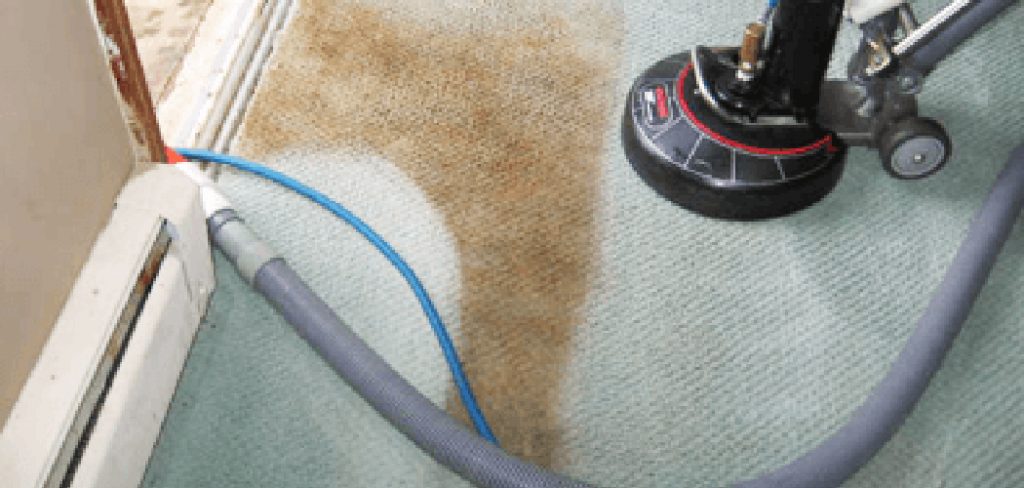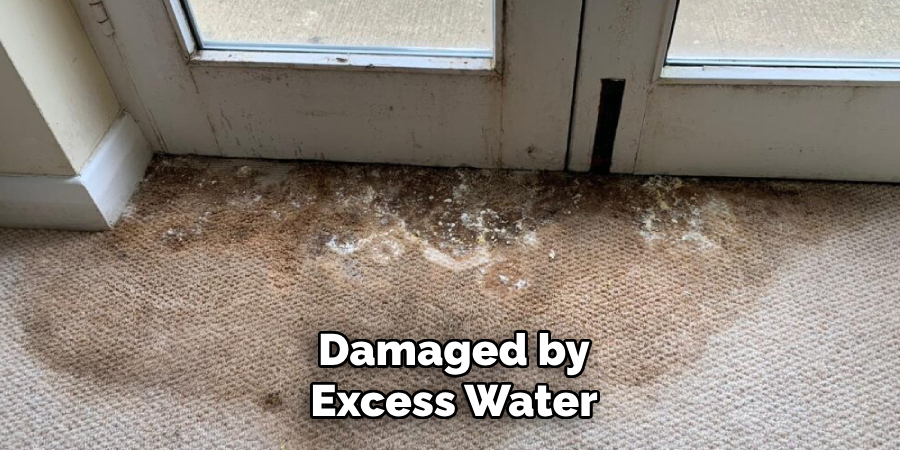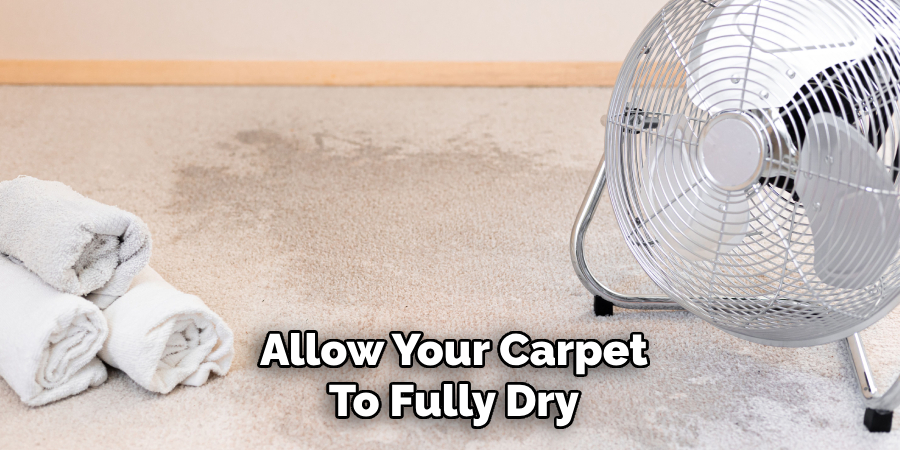Dry cleaning your carpet is an effective way to maintain its appearance and extend its lifespan without using excessive water or harsh chemicals.

This method is particularly useful for delicate materials or spaces where quick drying is essential. By learning the proper techniques and tools, you can keep your carpet fresh, clean, and free from dirt and allergens, ensuring a healthier environment for your home or office.
In this article on how to dry clean your carpet, we will cover the step-by-step process of dry cleaning, the benefits and advantages of this method, and some helpful tips to keep your carpet looking its best.
When to Choose Dry Cleaning?
Dry cleaning is an ideal choice for carpets that cannot withstand the excessive moisture involved in traditional wet cleaning methods. If your carpet is made from sensitive materials such as wool or silk, or if it has an intricate design that could be damaged by water, dry cleaning is a safer option.
This method is also highly recommended in situations where quick drying is important, such as in high-traffic areas or spaces that need to be used immediately after cleaning. Additionally, if you’re dealing with light surface stains, dust, or general maintenance, dry cleaning provides an effective and less intrusive solution. Knowing when to opt for dry cleaning can help prolong the life of your carpet and maintain its appearance.
Pros and Cons of Dry Carpet Cleaning
Pros:
Quick Drying Time:
Since minimal water is used, carpets can often be used immediately after cleaning, making it ideal for busy households or commercial spaces.
Convenient and Less Intrusive:
The process is faster and generally less labor-intensive, making it a hassle-free option for regular maintenance.
Prevents Mold and Mildew:
The reduced moisture eliminates the risk of mold or mildew developing, which is particularly important in humid environments.
Gentle on Delicate Carpets:
Dry cleaning is a safer choice for materials that may be damaged by excess water, such as natural fibers or antique rugs.

Cons:
Limited Deep Cleaning:
The method may not be as effective in removing deep-seated dirt and heavy stains compared to steam cleaning.
Chemical Residues:
Some dry-cleaning methods rely on chemical agents, which could leave residues behind and may be unsuitable for homes with children or pets.
Higher Costs:
Depending on the cleaning service or products used, dry cleaning may be more expensive compared to traditional methods.
Environmental Concerns:
Certain chemical-based cleaning products may have an ecological impact if not disposed of responsibly.
Weighing these pros and cons can help you determine whether dry carpet cleaning aligns with your needs and priorities.
Tools and Materials Needed
- Vacuum Cleaner
- Dry Carpet Cleaning Products (Powder or Foam)
- Stiff Bristle Brush or Broom
- Towels or Absorbent Cloths
- Optional: Spot Cleaner for Tougher Stains
8 Step-by-Step Guides on How to Dry Clean Your Carpet
Step 1: Vacuuming
Begin by thoroughly vacuuming the carpet to remove loose dirt, dust, and debris. This step is crucial as it preps the carpet surface for the dry cleaning process, ensuring the cleaning product can work effectively.
Use a high-quality vacuum cleaner with strong suction and ensure you pass over each section of the carpet slowly and methodically for optimal results. Don’t forget to vacuum corners, edges, and under furniture where dirt tends to accumulate.
Step 2: Spot Cleaning
Before moving on to the actual dry cleaning process, it’s important to spot clean any visible stains or spills on your carpet. This will help prevent these areas from becoming permanent stains after the dry cleaning process.
To spot clean, use a mixture of mild detergent and water and gently blot the stain with a clean cloth or sponge. Avoid rubbing the stain as it may cause it to spread or become deeper into the carpet fibers.
Step 3: Pre-Treat Any Heavily Soiled Areas
If your carpet has heavy traffic areas or stubborn stains that won’t come out with spot cleaning, you may need to pre-treat these areas before starting the dry cleaning process. There are various commercial pre-treatment products available in the market, but you can also make your own using equal parts of white vinegar and water.

Simply spray the solution onto the heavily soiled areas and let it sit for a few minutes before proceeding to the next step.
Step 4: Spread Dry Cleaning Powder
Once the pre-treatment has been applied and given time to work, it’s time to spread the dry cleaning powder evenly across the carpet. Start by sprinkling the powder over the entire carpet surface or focusing on specific areas where dirt and stains are more prominent. Use a clean broom or a soft-bristled brush to gently work the powder into the carpet fibers.
This action helps the cleaning agents in the powder bind to the dirt, stains, and oils trapped within the carpet. Make sure the powder is distributed evenly for the best results.
Step 5: Let It Sit
After working the dry cleaning powder into the carpet, allow it to sit undisturbed for the recommended amount of time specified on the product packaging. This waiting period is crucial, as it gives the cleaning agents sufficient time to break down and absorb the dirt, oils, and stains within the carpet fibers.
Typically, this can range from 15 minutes to an hour, depending on the product. Ensure no one walks on the carpet during this time to avoid uneven cleaning or pressing the dirt deeper into the fibers.
Step 6: Vacuum
Once the powder has had sufficient time to work, use a vacuum cleaner to thoroughly remove the dry cleaning residue from the carpet. Make sure to pass the vacuum over the treated area multiple times to ensure all particles are lifted, leaving the carpet clean and refreshed.
Pay extra attention to edges or corners where the powder may accumulate. This final step not only removes the cleaning product but also lifts dirt and debris, restoring the carpet’s appearance and texture.
Step 7: Spot Treat Any Remaining Stains
If there are any stubborn stains that were not completely removed by the dry cleaning powder, you can spot treat them using a carpet stain remover or a mixture of water and vinegar. Apply the solution directly to the stain and let it sit for a few minutes before gently blotting it with a clean cloth. Repeat as necessary until the stain is gone.
Step 8: Allow the Carpet to Dry
After completing all the above steps, it’s important to allow your carpet to fully dry before walking on it. You can speed up the drying process by using fans or opening windows and doors for air circulation. It typically takes a few hours for carpets to dry completely.

Following these steps on how to dry clean your carpet will not only remove stains and odors but also help maintain its quality and extend its lifespan. Regularly dry cleaning your carpet can also prevent the build-up of allergens, dust mites, and bacteria, making your home a healthier environment for you and your family.
Additional Tips
- Always read and follow the instructions on any cleaning products you use.
- Test any new cleaning solutions on a small inconspicuous area of your carpet first to ensure it doesn’t cause any damage or discoloration.
- Regularly vacuuming your carpet can help prevent dirt and debris from becoming deeply embedded in the fibers.
- Consider using a carpet protector or stain repellent to help keep your carpets cleaner for longer.
- If you have pets, use a lint roller or a specialized pet hair removal tool to get rid of any excess fur on your carpet before cleaning.
- Don’t forget about the importance of regularly cleaning and maintaining your vacuum cleaner as well. A dirty vacuum can actually make your carpet dirtier instead of cleaner.
- For tough stains, it may be best to call in professional carpet cleaners who have experience and specialized equipment for deep cleaning.
- Keep an eye out for any signs of mold growth on your carpets, and address it immediately with proper cleaning and ventilation.
Frequently Asked Questions
Q1: How Often Should I Vacuum My Carpet?
A: It is recommended to vacuum at least once a week, but high-traffic areas may need more frequent cleaning.
Q2: Can Vacuuming Damage My Carpet?
A: Improper use of a vacuum or using the wrong type of vacuum can potentially cause damage to your carpet. Make sure to read the manufacturer’s instructions and use appropriate settings for your specific carpet type.
Q3: How Do I Remove Tough Stains From My Carpet?
A: For deep stains, it is best to call in professional cleaners who have specialized equipment and experience in removing tough stains. For smaller stains, you can try spot cleaning with a mixture of water and mild detergent.

Conclusion
Proper care and maintenance of your carpet can significantly extend its lifespan and keep it looking fresh and clean. Regular vacuuming, prompt attention to spills, and professional cleaning when necessary are key practices to ensure your carpet stays in great condition.
By following these steps on how to dry clean your carpet and being mindful of the specific needs of your carpet type, you can create a welcoming and well-maintained space in your home.
About
Jennifer Branett is a distinguished figure in the world of Diy design, with a decade of expertise creating innovative and sustainable Diy solutions. His professional focus lies in merging traditional craftsmanship with modern manufacturing techniques, fostering designs that are both practical and environmentally conscious. As the author of diy, Jennifer delves into the art and science of furniture-making, inspiring artisans and industry professionals alike.
Education RMIT University
(Melbourne, Australia) Associate Degree in Design (Jennifer Branett) Focus on sustainable design, industry-driven projects, and practical craftsmanship. Gained hands-on experience with traditional and digital manufacturing tools, such as CAD and CNC software.
Nottingham Trent University
(United Kingdom) Bachelor’s in diyfastly.com and Product Design (Honors) Specialized in product design with a focus on blending creativity with production techniques. Participated in industry projects, working with companies like John Lewis and Vitsoe to gain real-world insights.
Publications and Impact
In diy, Jennifer Branett his insights on indoor design processes, materials, and strategies for efficient production. His writing bridges the gap between artisan knowledge and modern industry needs, making it a must-read for both budding designers and seasoned professionals.


